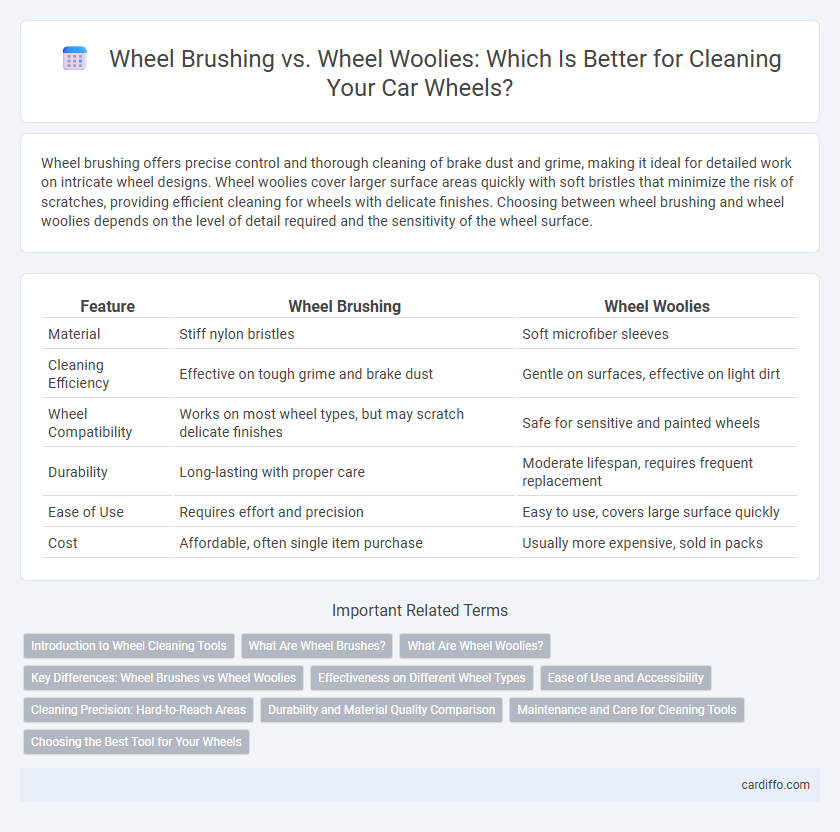Wheel brushing offers precise control and thorough cleaning of brake dust and grime, making it ideal for detailed work on intricate wheel designs. Wheel woolies cover larger surface areas quickly with soft bristles that minimize the risk of scratches, providing efficient cleaning for wheels with delicate finishes. Choosing between wheel brushing and wheel woolies depends on the level of detail required and the sensitivity of the wheel surface.
Table of Comparison
| Feature | Wheel Brushing | Wheel Woolies |
|---|---|---|
| Material | Stiff nylon bristles | Soft microfiber sleeves |
| Cleaning Efficiency | Effective on tough grime and brake dust | Gentle on surfaces, effective on light dirt |
| Wheel Compatibility | Works on most wheel types, but may scratch delicate finishes | Safe for sensitive and painted wheels |
| Durability | Long-lasting with proper care | Moderate lifespan, requires frequent replacement |
| Ease of Use | Requires effort and precision | Easy to use, covers large surface quickly |
| Cost | Affordable, often single item purchase | Usually more expensive, sold in packs |
Introduction to Wheel Cleaning Tools
Wheel brushing offers precise control for removing brake dust and grime from tight spaces, using stiff bristles that penetrate deep into wheel crevices. Wheel woolies feature soft, elongated fibers designed to cover larger surface areas efficiently while minimizing the risk of scratching delicate wheel finishes. Both tools serve essential roles in comprehensive wheel cleaning, catering to different cleaning needs and wheel types.
What Are Wheel Brushes?
Wheel brushes are specialized cleaning tools designed to remove dirt, brake dust, and grime from vehicle wheels, featuring stiff bristles that can reach into tight crevices and spokes. They come in various sizes and shapes, often with ergonomic handles to enhance control and efficiency during cleaning. Unlike wheel woolies, which use softer, finer fibers, wheel brushes provide more aggressive scrubbing power for tough contaminants.
What Are Wheel Woolies?
Wheel Woolies are specialized cleaning brushes designed with fine, soft wool or microfiber strands that conform to the intricate shapes of car wheels, providing gentle yet effective removal of brake dust and grime. Unlike traditional wheel brushes, Wheel Woolies reach into tight crevices and delicate surfaces without causing scratches, making them ideal for detailed wheel cleaning. These tools are favored by car enthusiasts and detailers for their ability to maintain wheel finishes while delivering thorough cleanliness.
Key Differences: Wheel Brushes vs Wheel Woolies
Wheel brushes feature flexible bristles designed to reach narrow spaces and remove brake dust and grime from intricate wheel surfaces, while wheel woolies consist of soft, microfiber-covered cylindrical heads ideal for cleaning lug nuts and detailed areas without scratching. Wheel brushes provide more aggressive scrubbing power for stubborn dirt, whereas wheel woolies offer gentle, targeted cleaning to preserve delicate finishes. Choosing between them depends on wheel design and the level of dirt, with brushes suited for deep cleaning and woolies for precision cleaning.
Effectiveness on Different Wheel Types
Wheel brushing offers precise cleaning on intricate alloy wheels, effectively reaching tight spokes and crevices without causing damage to delicate finishes. Wheel woolies excel at covering large surface areas quickly, making them ideal for deep-cleaning steel wheels and simpler wheel designs with minimal detailing. Choosing between the two depends on the wheel type and level of grime; woolies handle heavy brake dust efficiently while brushes allow for targeted treatment on complex wheel patterns.
Ease of Use and Accessibility
Wheel brushing offers a straightforward approach with minimal setup, making it highly accessible for most users, especially beginners. Wheel woolies, designed with soft microfiber strands, provide gentle cleaning but often require more careful handling and time to avoid damage on delicate wheel finishes. The ease of use favors wheel brushing for quick, effective grime removal, while wheel woolies excel in detailed, scratch-free cleaning but demand a gentler touch and slightly higher skill level.
Cleaning Precision: Hard-to-Reach Areas
Wheel woolies excel in cleaning precision, especially in hard-to-reach areas, due to their soft, densely packed fibers that conform to intricate wheel designs and tight spaces. Wheel brushing offers more aggressive scrubbing power but may struggle to access narrow crevices without causing damage. For detailed cleaning of complex wheel patterns, wheel woolies provide superior coverage and gentle yet effective dirt removal.
Durability and Material Quality Comparison
Wheel brushing typically offers higher durability due to its use of hardened nylon or stainless steel bristles that resist wear and deformation over time. Wheel woolies, constructed from softer, microfiber or lambswool materials, excel in gentle cleaning but tend to wear out faster with heavy use. The material quality in wheel brushes ensures longer lifespan and consistent performance, while wheel woolies prioritize delicate surfaces at the expense of longevity.
Maintenance and Care for Cleaning Tools
Wheel brushing requires regular inspection of bristles for wear and debris buildup to maintain optimal cleaning performance and prevent damage to wheels. Wheel woolies demand gentle rinsing after use to remove accumulated dirt and prevent fibers from matting or deteriorating, ensuring prolonged tool lifespan. Proper storage in a dry, clean environment is essential for both tools to avoid contamination and preserve their effectiveness.
Choosing the Best Tool for Your Wheels
Wheel brushing offers precision and control for intricate wheel designs, effectively removing brake dust and grime from tight spaces, while wheel woolies provide a quicker, gentler clean for larger surface areas with less risk of scratching. Considering wheel material and finish is essential; soft woolies suit delicate finishes like chrome or painted alloys, whereas stiff-bristled brushes excel on rugged steel or heavily soiled wheels. Selecting the right tool depends on balancing thorough cleaning needs with preserving the wheel's surface integrity for long-term maintenance.
Wheel brushing vs Wheel woolies Infographic

 cardiffo.com
cardiffo.com